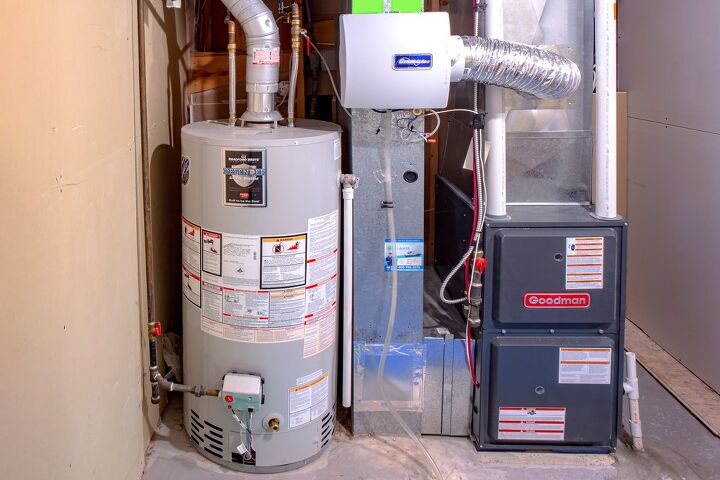Furnace Keeps Turning On And Off? (Possible Causes & Fixes)
You’ve spent a lot of money on your home’s HVAC system and smart thermostat. That makes it even more frustrating when for some reason, the furnace keeps turning on and off. One minute hot air is blasting from the vents, and the next it feels like you’re in a cryochamber. What is the explanation for this annoying situation, and what can you do to fix it?
Your furnace probably keeps turning on and off because of a dirty air filter or flame sensor. You may also have an electrical issue or a faulty thermostat. Check the air filter and clean or replace it as needed. Check and replace any blown fuses in the electrical panel. And if these don’t work, you may need to replace your thermostat.
When a heating system is working properly, it turns on and off around 3-6 times an hour. If it’s more rapid than that, your furnace is short-cycling.
Do You Need a Furnace Repair Contractor?
Get free, zero-commitment quotes from pro contractors near you.

Furnace Turning On and Off? – Troubleshooting Issues
There are a few different reasons your furnace might keep turning on and off. It is most likely related to poor airflow. But it may also be a thermostat or electrical issue.
Whatever the reason, you’ll want to troubleshoot it as soon as you can. That way your electricity bill doesn’t skyrocket, and your home climate stays controlled. Here are common reasons your furnace may be turning on and off, and simple fixes.
Note: Before doing any work, cleaning, or troubleshooting, shut off gas and electricity to the HVAC.
Dirty Air Filter
A dirty air filter is one of the most likely causes of a flaky furnace. Air filters in furnaces ensure that the air circulating through your home is clean and safe to breathe. It also contributes to proper levels of airflow. When an air filter becomes caked with grime, airflow through the furnace becomes low.
There are many negative side effects to a dirty air filter, including:
- Higher electricity bills
- Bad air quality
- Furnace repeatedly shutting off
- Accelerated wear and tear on HVAC system
Air filters don’t have an infinite lifespan. Depending on the type, the average air filter lasts between 30 days to 6 months. If you’re not changing it out regularly enough, you may have a clogged air filter.
When the air filter is blocked, the furnace doesn’t have proper airflow and can get overheated. It cannot effectively detect the temperature in your home, so it short-cycles. If your furnace won’t turn on automatically or is frequently turning off and on, check the air filter for dirt and grime.
If you haven’t replaced it in 30 days to 6 months, it’s time to clean or replace it. Depending on the type, quality, and size, air filters will cost anywhere from $5 to $100 to replace. It’s an affordable alternative to the more serious damage a long-term clogged air filter causes to your HVAC system.
Blocked Air Vents
When your furnace shuts on and off repeatedly — something called short-cycling — it’s likely related to airflow. Like a dirty air filter, blocked air vents affect the proper circulation of airflow through the furnace. Low airflow to the furnace confuses temperature readings.
Keep the air vents in your home opened so air can circulate. Closed vents can cause warm air to build up in the furnace. It is also a good idea to check for any foreign or large objects that may be lodged in the air vents. Major blocks in the vents will affect the climate control accuracy for your HVAC.
Dirty or Corroded Flame Sensor
Another cause of a furnace shutting on and off is a dirty or corroded flame sensor. A flame sensor is a thin metal rod on the burner assembly of your furnace. It is an important safety feature for your HVAC system. It detects the flames from when the pilot light ignites the gas chamber.
If it does not detect the flame, it powers everything down to prevent dangerous gas from leaking into your home. When the flame sensor collects too much soot, it may not be able to detect the presence of a flame. This shuts down the heating system, preventing warm air from cycling through the furnace.
Your flame sensor will need to be cleaned or replaced if it’s corroded. You can complete this process yourself, but it isn’t the most simple. If you’d like to do it yourself, Here are the basic, simplified steps to cleaning the flame sensor:
- Turn off the furnace.
- Unscrew the sensor, and remove it from the furnace.
- Clean the sensor using steel wool, a wire brush, or sandpaper. Wipe down remaining residue with a towel.
- Reconnect the sensor the same way you removed it.
- Power the furnace back up.
If you’re not familiar with furnace components, it’s a good idea to call a professional for this.
Faulty Thermostat
Another culprit of a haywire furnace is a faulty or damaged thermostat. The primary function of a thermostat is to send signals to the furnace about what temperature to set. The thermostat lets it know to release warm air, or to shut off.
If the thermostat has faulty wiring or a dying battery, it cannot properly communicate with the furnace. It will either not be able to send any signals to the furnace, or it will send incorrect temperature readings.
So how do you know if you have a faulty thermostat? The main tell-tale sign is a short-cycling furnace, or a furnace that does not respond when you make temperature setting changes. You can also take these troubleshooting measures:
- Check the thermostat screen: Is it not lighting up? Not responding when you touch it or press the buttons? The battery might be dead.
- Check the battery life: Do you have a smart thermostat? You can check the battery life by scrolling through the settings on the home screen. If your analog thermostat is dark or has flickering backlighting, the batteries may be on the fritz.
- Check any error codes: Smart thermostats like the NEST will provide error codes when something is faulty. Address any error codes that may be popping up on the display.
If your thermostat is faulty, you may need to reconnect wires yourself, or call in a technician to fix or replace it.
Electrical Issues
Another scenario is your furnace is not getting the electrical supply it needs to run. The furnace may be drawing more energy than the circuit could handle. This can trip the breaker or blow a fuse, depending on your furnace.
A blown furnace fuse can happen for various reasons. A dirty air filter, damaged wiring, or faulty furnace components can trigger it. There are simple steps to check for a tripped circuit breaker, or blown fuse:
- Locate the circuit breaker box or fuse box. Circuit breaker boxes have circuits that are connected to individual rooms or appliances in your home. Often, the furnace has its own designated circuit breaker box. If your furnace has a fuse, you will likely find it in the control box by the blower. These electrical panels are often metal, grey, and have switches inside.
- Check for flipped switches or blown fuses. It’s relatively easy to tell if you have a tripped breaker. If all the switches are in the ON position, and the furnace switch is in the OFF position, you have a tripped circuit. To check for a blown fuse, look to see if the fuse has broken wires. It may also be discolored or cloudy. And if it is blown, using a multimeter on it will show no reading.
Tripped circuit breakers are easy fixes. Just flip the switch back into the ON position, and your furnace should power back up. If you have a blown fuse on your hands, the fuse will need to be replaced.
You can do this yourself, just make sure you buy the exact brand your furnace requires. Ensure it’s compatible before installing.
Always proceed with caution when performing electrical installations. If you’re not familiar with the process, you should call in an electrician to do the fuse replacement.
Do You Need a Furnace Repair Contractor?
Get free, zero-commitment quotes from pro contractors near you.

Related Questions
Why does the furnace fuse keep blowing?
Loose wires in the furnace can cause an electrical short and a blown fuse. Worn furnace components may also contribute to a blown fuse. In more rare instances, if a thermostat wire touches the metal frame of a furnace, it can deliver a higher voltage than can be handled. Also, incorrectly installed fuses can blow.
What furnace filter do I need?
There are important factors to consider when purchasing a furnace air filter. The size of the filter cabinet, the efficiency level, and pleated or non-pleated style are all important to consider. Filters with the highest MERV (efficiency) rating will cost the most, but will also purify the air the best. Pleated filters last longer. And check the required filter size for your specific furnace. The door of your filter cabinet will indicate the correct measurements to purchase.
Why is the thermostat blank?
If your thermostat is blank, it’s likely due to a dead battery. When the thermostat battery dies, the display lights will go dark and the batteries will need to be replaced. In certain cases, a blank thermostat may also indicate a tripped circuit breaker. When this happens, reset the circuit switch.
More by Jessica Vaillancourt



























